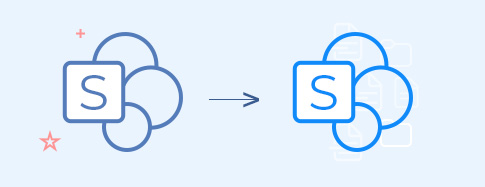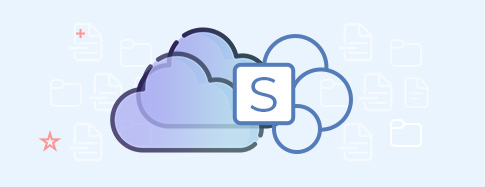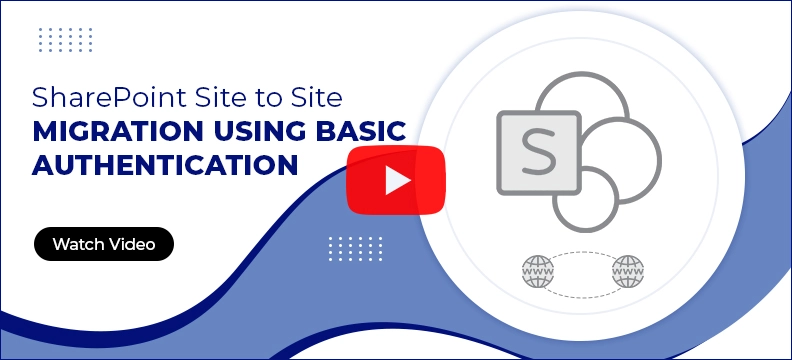Common Scenarios for using the SharePoint Data Migration Tool
Check out all the common business scenarios where this SharePoint site migration tool can help you securely move data to SharePoint site.

On-premises SharePoint to SharePoint Online
Migrate data from any of the SharePoint site collections to another SharePoint Online, including sites, lists, libraries, workflows, web parts, versions, etc. The software allows you to execute SharePoint document migration from the on-premises SharePoint environment to SharePoint Online.

Tenant-to-tenant migration in Microsoft 365
Download free trial of Kernel Migration for SharePoint software to instantly migrate to SharePoint sites from one tenant to another. It supports cross-tenant migration and seamlessly transfers all the SharePoint objects from source to destination SharePoint sites.

Transfer site metadata and permissions
The migration tool for SharePoint provides secure SharePoint migration services and allows you migrate site metadata, permissions, and objects. It allows the mapping of source and destination tenant users for preserving site membership such as owners, members, site admins, site groups, and visitors.

Kernel Migration for SharePoint is the best tool for SharePoint Online Migration. It helps you conduct a pre-migration analysis and accomplish the migration with ease. Nice work by the software team."

I faced a scenario when I needed to upgrade from SharePoint 2013 to SharePoint 2016. Trust me, the process is not that simple as it looks. That is why professional SharePoint Migration tools are in demand. Read more”
Core functionalities of Kernel SharePoint Migration Tool
Kernel SharePoint Migrator is one of the best SharePoint migration utilities that deliver effortless, seamless, and secure SharePoint content migration.
Migrate bulk SharePoint sites and sub-sites
The software allows you to transfer bulk SharePoint site collections including all types of sites (Team, Communication, other templates) & sub-sites to the destination tenant as new or existing sites. Migrate SharePoint site content, including Documents, Form Templates, Site Assets, Style Library and Pages, while preserving the site settings, look and feel, quick launch, views, and permission levels.
Multiple list and library migration
Free download SharePoint site migration tool to migrate entire data of SharePoint lists (with default and custom rows & columns such as Title, Attachments, ID, Modified By, etc.) and libraries to the destination. Allows migrating SharePoint list and library views (List, Compact List, Tiles, and Custom views) in the same structure.
Migrate single/multiple active sites
Use the SharePoint migrator to perform single or multiple active sites (site collection) migration. The software allows seamless migration of multilingual sites and template-based sites from the source to the destination while preserving site types, whether private or public, and maintaining language settings at the destination.
Advanced filters
Use the advanced filters to migrate only specific content to SharePoint according to requirements and save a lot of time. The tool offers rich features and precise filtering options, including versions, permissions, dates, and file filters to meet the needs of end users, SharePoint admins, and MSPs.
Automation of the migration
The software allows users to automate the migration process by scheduling the job on a daily, weekly, and monthly basis. It enables users to run the SharePoint content migration simultaneously and helps complete the migration projects on time.
Detailed migration history
The SharePoint site migration tool keeps a detailed migration summary of every migration process. It allows the user to validate the progress of the migration status and helps to track real-time progress of the SharePoint document migration. The software enables the saving of all process records for detailed analysis.
SharePoint Online backup
SharePoint migration software allows hassle-free SharePoint tenant backup, including bulk sites, lists and libraries. It supports both SharePoint On-premises and SharePoint Online backup. It takes a SharePoint site backup to local or network-attached storage on your system, as per the user's needs.
Support Microsoft 365 Government plans
Software is designed for the unique SharePoint migration services needs of government organizations. It easily connects secure Government clouds, enabling organizations to meet U.S. compliance and security standards. The software supports:
Government clouds: Microsoft 365 GCC High, DOD, Office 365 (Microsoft 365) Government G3, G5
Endpoints: acesscontrol.windows.net, microsoftonline.us, microsoftonline.de, acesscontrol.chinacloudapi.cn
File Share to SharePoint Migration
Software allows easy SharePoint Document upload from file shares. It securely migrate file server to SharePoint (on-premises and online). Additionally, it provides pre-migration analysis of files and folders, which helps to identify the migration data state before starting the migration.
Google Drive to SharePoint Migration
Use the SharePoint data migration tool to migrate Google Drive to SharePoint. It allows effortless migration of content from Google users’ My Drive, Shared Drive and Shared with me. Users can quickly map source Google tenant and destination tenant users and migrate bulk or selective users’ drives to SharePoint.
OneDrive to SharePoint Migration
Migrate entire OneDrive data, including permissions, along with the data files and folders to SharePoint in their original hierarchy. Transfer bulk data from 'My files', 'Shared (With you and By you)', 'Photos', and other folders within OneDrive to SharePoint with zero data loss.
Migrate Cloud Storage Files to SharePoint Online
Utilize the SharePoint migration utility to effortlessly move data from cloud storage (Amazon S3, Dropbox, and Box) to SharePoint Online. Connect the cloud application with the tool, select the directories, apply filters according to your needs, and all the required data will be moved to your SharePoint sites.
Discover the Benefits of Using Kernel SharePoint Migration Software
SharePoint migration services help users to perform SharePoint content migration in several ways. Check out software’s benefits that make it a preferred choice over others.
Migrate to Microsoft 365
Migrate data from various sources, SharePoint, Teams, Chats, Planner, Public Folders. File Shares, Google Drive, Dropbox, Box, Amazon S3 buckets and OneDrive, to Microsoft 365. It is the best all-in-one solution for migrating multiple platform data to Office 365.
Free Trial version
Download the free trial version of SharePoint migrator and use it for free for 15 days. The free version offers a facility to evaluate the software as per your requirements before purchasing. We provide an on-demand trial license, as per your migration project needs.
Selective migration of data
Migrate all or selective data from the source to the destination. Rather than moving the whole site collection, choose the data that you require in the destination SharePoint environment.
View migration logs and summary
The software generates detailed migration logs and a summary providing insights into the status of the data items migrated. Preview the complete SharePoint data migration summary and save it as a CSV file on the local machine.
Dual authentication login modes
Connect with SharePoint migration utility using dual authentication modes to move files from one SharePoint site to another securely. Use Basic Authentication or Modern Authentication as per your needs to connect the SharePoint site to the tool.
Version history migration
Successfully move SharePoint list to another site with recently updated versions of documents in lists & library. The tool allows users to migrate versions, including all, or most recent versions. The SharePoint migration tool will keep the version history the same as in the destination.
The software handles the migration of the following SharePoint objects:
Kernel SharePoint Migration Tool allows the migration of the following objects to easily migrate Google Drive to SharePoint, and other sources.
Use the free migration tool for SharePoint to migrate all sorts of sites from on-premises/online SharePoint to SharePoint (Online, 2019, 2016, 2013, and others).
- Collections
- Collection features
- Subsites
- Assets
- Columns
- Navigations
- Pages
- Web parts
Migrate entire SharePoint lists with default and custom rows and columns such as Title, Attachments, ID, Type, Modified By, Created By, etc. and libraries. Preserve item IDs of lists and libraries in the destination. Allows migrating SharePoint list and library views such as List, Compact List, Tiles, and Custom views.
- Lists & libraries
- Documents
- Contents
- Types
- Timestamps
- Styles
- Items
- Views
Move SharePoint site to another site with all of its content & metadata, including Documents, Form Templates, Site Assets, Style Library, Site Pages, and user-define lists & Libraries.
- AppData
- Managed
- Alerts
- Created by
- Modified by
- Document ID
- Versions
- Owner/author
Download software’s free trial version to migrate SharePoint permission (user and group level), workflows (Nintex and custom workflow), forms, Infopath forms, and Nintex forms to SharePoint.
Connect public folders to the source and simply migrate all the data, including messages, calendar entries, contacts, tasks, notes, etc., to SharePoint on-premises or online.
- Public folder data
- Permissions
- Permission levels
SharePoint migration tool maps and transfers all types of Teams data to SharePoint, which includes:
- Members
- Chats
- Channels
- Folders
- Files
- Tabs
- GIFs
- Emojis
Frequently Asked Questions about the SharePoint Migration Tool
- Step 1: Download Kernel Migration for SharePoint tool and install it.
- Step 2: Launch the software and choose the SharePoint (On-premises/Online) option from the left pane.
- Step 3: Right-click and select "Add new SharePoint Site."
- Step 4: Add a single site or multiple sites or select specific sites from the list.
- Step 5: Select the preferred login type: Basic or Modern Auth.
- Step 6: After login, the added site(s) will appear in the source. All sites, sub-sites, documents, lists, and libraries will be listed in the software's left pane.
- Step 7: Pick out the site, specific list & library, or documents to migrate to the destination environment, whether new or existing site/sub-site.
- Step 8: For migration to an existing site/sub-site, add the destination SharePoint site as you added source SharePoint site(s).
- Step 9: Migrate selected data from the source SharePoint to the destination using the "Copy" or "Copy to" option.
- Step 10: Use the advanced filters provided within the software for easy and selective data migrations.
- Migrate only 5 items per folder.
- Do not migrate subsites.
- Migrate only 5 lists or libraries.
- Date filter (file access, file creation, and file modification)
- File filter (file name, file extension, and file size)
- Step 1: Launch the SharePoint data migration tool, go to the CSV Generation option at the top of the welcome page.
- Step 2: Select File System from the dropdown.
- Step 3: From the Select Source page, click on Add dropdown button to add files and folders from local or remote drive.
- Step 4: Choose the files and folders to be included, with an option to view Group or User Permissions. Click Next.
- Step 5: Browse the destination on your drive where you want to save the CSV file on the system. Give it a name and click on Save and then Next.
- Step 6: Go through the Summary and your CSV file is now ready for seamless bulk migration.
- Step 1: Open the tool and right-click on SharePoint (On-Premises/Online). Now click on Add New SharePoint Site.
- Step 2: In the Site Connection (s) option, click the Find/Add Multiple Sites button.
- Step 3: Choose Connection Type and provide the required SharePoint credentials, such as Central Admin URL, Central Admin User Name, and Central Admin Password, then click Next.
- Step 4: Select required sites from the list, ensuring their accessibility and using the search feature. Click Finish after selection.
- Step 5: Enter a project name and click OK.
- Step 6: In the popup asking to connect the same site (s) in the source as the destination, select No.
- Step 7: All sites will be connected in the source pane, maintaining their respective tree-like structures.
- Download the SharePoint Online Management Shell tool from the following URL- https://www.microsoft.com/en-in/download/details.aspx?id=35588
Basic Authentication - when you connect using the Basic Authentication option (through user ID and password), then run the new cmdlet-
Connect-SPOService -Url https://contoso-admin.sharepoint.com -credential admin@contoso.com
Modern Authentication - when connecting with Modern Authentication, execute this new cmdlet:
Connect-SPOService -Url https://contoso-admin.sharepoint.com
A new wizard will pop up, asking for the credentials of the Office 365 Administrator account. Enter the necessary credentials.
- Run the second cmdlet:
Set-SPOTenant -DisableCustomAppAuthentication $false
After executing the command, wait for at least 5 minutes to save the changes. After that, you can connect with your SharePoint account, and there will be no error 401.
- Right-click the root SharePoint Server and choose Add New SharePoint Site.
- Enter the project name and site address. Note: If performing SharePoint data migration of multiple sites, click 'Find/Add Multiple Sites' to enumerate all site collections.
- Provide the Office 365 SharePoint site's URL and admin login credentials.
- Provide the project name and Office 365 credentials manually.
- Click Submit and you can add the desired SharePoint site to the destination.
How to use SharePoint Migration tool?
Watch the video tutorial to learn how the Kernel SharePoint Migration Tool works
SharePoint Migration Supported
 Microsoft Teams migration
Microsoft Teams migration-
 Microsoft Teams Backup
Microsoft Teams Backup  File Server to SharePoint
File Server to SharePoint Public Folder to SharePoint
Public Folder to SharePoint Dropbox to SharePoint
Dropbox to SharePoint Box to SharePoint
Box to SharePoint Amazon S3 to SharePoint
Amazon S3 to SharePoint Microsoft Planner Migration
Microsoft Planner Migration File Server to OneDrive
File Server to OneDrive File Server to Google Drive
File Server to Google Drive Google Drive migration
Google Drive migration Google Drive to SharePoint
Google Drive to SharePoint OneDrive migration & backup
OneDrive migration & backup

Professional SharePoint migration services
Let our Migration experts streamline your SharePoint migration with proven methodologies.
Enquire nowSharePoint Migration Software Prerequisites & recommendations
Version: 25.4
Release Date: Aug 2025
Exchange Server: Exchange Server Online (Microsoft 365)/ 2019/ 2016/ 2013/ 2010/ 2007/ 2003/ 2000
Outlook: Outlook 2019/ 2016/ 2013/ 2010/ 2007/ 2003
SharePoint Servers: SharePoint 2013/ 2016/ 2019/ SharePoint Online (Office 365), SharePoint Server Subscription Edition, SharePoint Foundation 2013/ 2010, SharePoint Server 2010
Virtual Environments: Hyper-V Server, VMware ESX/ ESXi Server, Microsoft Virtual PC
Hard Disk: 4 GB free space for the installation and data migration
Memory: Minimum 4 GB RAM
Processor: Intel® Pentium 4 Class or higher Processor
Operating System: Windows 365 (Cloud PC)/ 11/ 10/ 8 /7 Service Pack 1, Windows Server 2022/ 2019/ 2016/ 2012 R2/ 2012/ 2008 R2/ 2008/ 2003
What customers say about Kernel Migration for SharePoint
Before migration, I also benefit from per-migration analysis. To ensure that the process is result-oriented and obstacles are avoided. The filter option it has is also very good.

